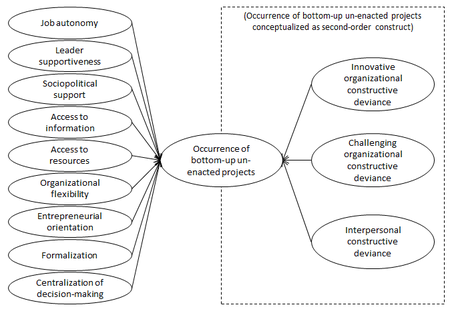|
Un-enacted projects are those projects that have not been officially evaluated by the project portfolio management but do exist although they are not known to a company’s project portfolio. As a consequence, resources thought to be available often prove to be actually unavailable and that unofficial initiatives eventually compete for scarce resources. One particular type of these un-enacted projects are bottom-up initiatives. Bottom-up un-enacted projects are unofficial initiatives on which employees spend time without order but with which they intend to benefit their organizations. While previous research highlights the great potential of bottom-up un-enacted projects, they only focus on the individual level but leave the organizational level for further research. In a recent research project, we aimed at gaining a deeper understanding of the organizational drivers of bottom-up un-enacted projects. We draw on deviance theory to develop a conceptual model for explaining the occurrence of these projects. In order to triangulate the emerging model with insights from practice, we use interview data to cross-check and refine the theory-driven model. The key result of our work is a conceptual model that comprises the organizational antecedents to explain the occurrence of bottom-up un-enacted projects. Model explaining the occurrence of bottom-up un-enacted projects
Our results advance the theoretical discourse on the concept of un-enacted projects by proposing a conceptual model for explaining the occurrence of a specific type of un-enacted projects, namely bottom-up initiatives, from an organizational perspective. By relying on organizational deviance theory as a theoretical lens, our study is one of the first that applies this reference theory to the field of information systems in general, and more particular to the domain of project portfolio management. From a practical point of view, we expect our model after a thorough empirical evaluation to be a beneficial instrument to evaluate and predict the occurrence of bottom-up initiatives in a particular organizational setting. Having identified the levers for the emergence of such un-enacted projects, responsible practitioners will receive a basis for steering their organization in the intended direction. The research results have recently been accepted for publication: Buchwald, A., Urbach, N. and Ahlemann, F. (2014) Understanding the Organizational Antecedents of Bottom-Up Un-Enacted Projects – Towards a Conceptual Model Based on Deviance Theory, Proceedings of the 22nd European Conference on Information Systems (ECIS 2014), June 9-11, Tel Aviv, Israel. (Link)
1 Comment
|
Archives
December 2015
Categories
All
|

 RSS Feed
RSS Feed